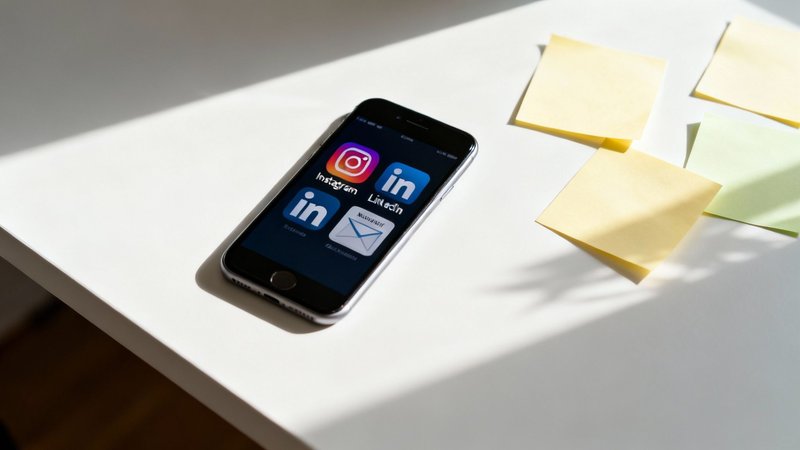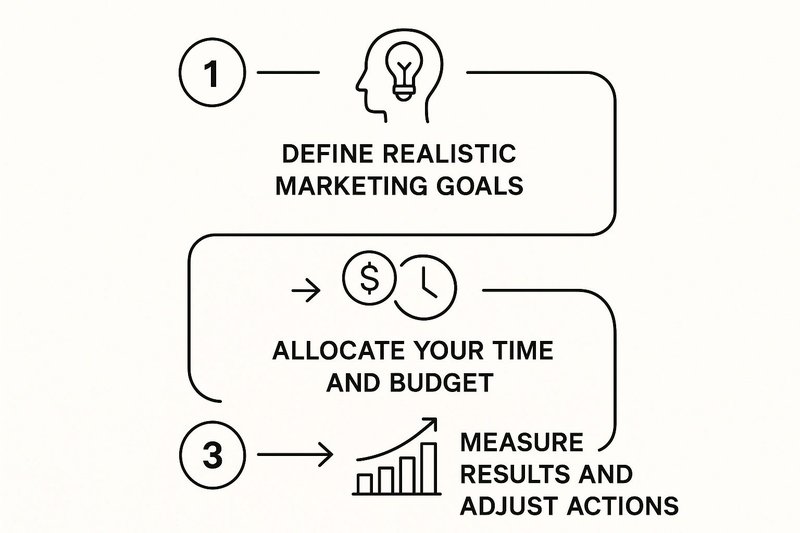
Your Small Business Marketing Strategy Guide
Build a small business marketing strategy that works. This guide offers practical, no-nonsense tips for real results, designed for Australian business owners.
21 Oct 2025
Finally, a practical marketing strategy for small business owners in Australia. No jargon, just real-world advice to help you connect with customers and grow.
Blog
The phrase 'marketing strategy' sounds a bit corporate and stuffy when you're busy running your own show, doesn't it? It conjures up images of complicated charts and buzzwords, something for big companies with massive teams and even bigger budgets.
But what if we thought about it differently?
What if a marketing strategy is just your simple, honest plan for telling people about the incredible thing you do? That's it. It’s about building a genuine connection with the right people. I remember when I started my first little venture... my entire marketing plan was literally a few notes scribbled on a cafe napkin. And you know what? It worked, because it was real.
This guide is all about ditching the jargon. And the fear. We’re going to talk about the reality of being a small business owner in Australia... the constant juggling act... and why having a clear direction for your marketing isn't just a 'nice to have'. It’s the very thing that will help you survive and, more importantly, thrive.
Being a small business owner is a tough gig. You're the CEO, the bookkeeper, the customer service rep... and the marketer. It's so easy for marketing to fall to the bottom of the to-do list when you're putting out fires all day.
But here’s the thing: you're not alone in this. Small businesses are the absolute backbone of the Australian economy. In fact, businesses with fewer than 20 employees make up a staggering 97.2% of all Australian businesses, employing over 5.1 million people. That's huge.
The hard truth, though, is that about 60% of them fail within the first three years, often because they struggle to find and keep customers. This is made even tougher when you realise almost half of companies still don't have a structured marketing strategy. It's like trying to build flatpack furniture without the instructions. You'll get something done, but it'll probably be wobbly and you'll have a bunch of weird bits left over.
A plan isn’t about restricting you; it’s about freeing you up. It stops you from wasting precious time and money on random acts of marketing that lead nowhere. It gives you focus.
A good, simple marketing plan helps you:
Think of this guide not as a rulebook, but as the beginning of a more intentional way to grow your brilliant business. Let’s build a plan that feels less like a corporate manual and more like a chat with a mate who's been there, done that, and genuinely wants to see you win.
Before you spend a single dollar on an ad or post another thing on social media, we need to get crystal clear on who you're actually trying to reach.
It’s so easy to fall into the trap of thinking 'everyone' is your customer. But when you try to talk to everyone, you end up connecting with no one. I’ve seen so many brilliant business owners burn out because they’re spreading themselves too thin, trying to be everything to everybody. It’s heartbreaking.
It’s like shouting into a crowded room versus having a meaningful conversation in the corner. Let’s get specific.

Who is that one person who absolutely loves what you do? Let's dig deeper than just their age and location. What keeps them up at night? What are their secret hopes? What makes them laugh?
We’re not building a cold, data-driven 'customer avatar'. No thanks. We're painting a picture of a real, living, breathing human being.
Forget those generic persona templates for a minute. The best insights often come from simply listening to the people you already serve. They hold all the clues.
I once worked with a client who thought their ideal customer was a high-flying tech executive. But after a few simple chats with their existing clients, we realised their real ideal customer was the overworked finance manager who was desperate for a simple, elegant solution. She just wanted her weekends back.
That small shift in perspective changed everything for their marketing. Everything.
Understanding your ideal customer on a deeper level is your secret weapon. It’s the difference between marketing that feels like a generic flyer and marketing that feels like a recommendation from a trusted friend.
To start sketching out this person, ask yourself a few simple questions:
This process isn't about excluding people. It's about focusing your energy so your message resonates deeply with those who need it most. Once you nail that, you can always broaden your approach later.
If you’re keen to dive deeper, you can learn more about how to nail marketing to different segments and demographics in our other guide. It’s a great next step after you’ve got this foundation sorted.
This focus is the first real step in building a marketing strategy for your small business that actually works.

Okay, so you know who you’re talking to. Now for the big question... where do they actually hang out?
The pressure to be on every single platform is immense. Facebook, Instagram, TikTok, LinkedIn, a blog, maybe even a podcast? It's like trying to be the life of five different parties at the same time. You’ll just end up exhausted with a pocket full of half-eaten party pies.
Let's get strategic. This isn't about chasing the latest shiny trend. It’s about making smart choices that fit your personality, your business, and most importantly, where your ideal customers are already spending their time.
I once worked with a small business owner who was convinced she had to be on TikTok. All her competitors were. She spent weeks trying to learn the dances and point at text bubbles on the screen... and she hated every second of it. It just wasn't her.
Her customers? They were mostly on LinkedIn and reading industry blogs. Once she gave herself permission to quit TikTok and focus her energy where it mattered, her business started to grow. She went from feeling overwhelmed to feeling empowered. Big difference.
The goal here is focus. We'll find your sweet spot so you can show up consistently and make a real impact instead of just adding to the noise. For many small businesses, social media platforms are indispensable channels for reaching and engaging their audience. To maximise impact, explore effective strategies for leveraging a strong social media marketing for small business.
The best marketing channel for you is the one you can show up on consistently, authentically, and where your ideal customer is already listening. Don't force it.
Think about your business's online presence as having a 'home' and 'outposts'. Your home is your website and maybe a blog. It's the one place you completely own and control. The outposts are your social media channels, where you go to meet people and invite them back to your home.
Speaking of blogs, they’re not dead. Far from it. In fact, companies that maintain active blogs attract 55% more website visitors than those that don’t. This is especially relevant in Australia, where 90% of small businesses are at least partially digitalised, but most are still figuring out how to make it all work effectively.
Here are a few popular channels to consider for your marketing strategy for a small business:
Start with one or two channels. Do them really well. And then you can think about expanding.
Alright, this is where the magic really happens. You’ve figured out who you're talking to and where you’re going to find them. Now, the big question is… what are you actually going to say?
So many businesses get completely stuck right here. It’s a classic trap. We get so wrapped up in what we do... our features, our services, our company history... that we forget to answer the one question every single customer is silently asking.
"What's in it for me?"
Your message needs to do more than just list facts; it has to be magnetic. It needs to show your customers that you get it. That you genuinely understand their struggles and have the perfect solution ready for them.
Let's work on shaping a core message that’s simple, clear, and laser-focused on the benefits you provide, not just the things you sell. A feature is what something is. A benefit is what it does for the customer.
I once worked with a landscaper who kept telling potential clients about his high-tech, commercial-grade lawnmower. Honestly, no one cared. When we switched his message to "We give you your weekends back," his business absolutely exploded.
That's the shift. He stopped selling a piece of equipment and started selling a feeling.
People don't buy products; they buy better versions of themselves. Your marketing message should be a mirror, showing them what's possible with your help. It’s about turning your marketing from a sales pitch into a genuine conversation that builds trust.
Let's be real, people don’t remember data points. They remember stories.
Think about it. When a friend tells you about their terrible holiday, you remember the story of the lost luggage and the dodgy hotel, not the exact flight number. Stories stick with us because they make us feel something.
In Australia, the focus on customer experience has become a massive deal. In fact, a recent study found 43% of businesses credit their growth to improving it. And nearly 90% of marketers see a positive return after personalising their campaigns... which is really just a fancy way of saying they made their message feel like it was written for one person.
You don't need to write a novel to weave a story into your marketing. Just a simple structure will do:
This simple arc turns a boring product description into a compelling narrative that actually connects. As you start thinking about your channels, looking at successful content marketing strategy examples can show you how others tell their stories effectively and give you some great ideas.
Alright, let's bring it all together. An idea without a plan is just a wish. This is where we turn all those great thoughts about your customers and your message into a simple, actionable roadmap.
Forget those 50-page strategy documents that just gather dust on a shelf. We’re talking about something you can actually use. Something you can glance at every week and know exactly what you need to do next.
Because at the end of the day, the best marketing strategy is the one you actually follow.
The biggest hurdle I see small business owners face is trying to do too much, too soon. They build a monstrous plan that would require a team of ten, then feel like a failure when they can't keep up. Let’s not do that.
Instead, let’s aim for a one-page plan. Seriously. It’s a concept that forces you to focus only on what truly matters. If you're looking for a great template and a deeper dive, check out this guide on how to create a one-page marketing plan. It’s a genuine game-changer.
The real goal here is to create momentum. Small, consistent actions always add up to big results over time.
This infographic breaks down the basic flow of creating a simple, repeatable marketing process.

It really is that straightforward: a continuous loop of setting goals, taking action, and then checking your results to inform your next move.
When you feel like you don't have a marketing budget, remember this: your time is your biggest asset. Where you choose to spend your hours is your marketing budget.
Think about it in terms of simple, manageable chunks of effort.
That’s it. It’s not about finding an extra 20 hours a week; it’s about using the pockets of time you already have in a focused way.
Don’t aim for perfection; aim for progress. A messy plan that gets executed is infinitely better than a perfect plan that never gets started.
The final piece of this puzzle is measurement. Don’t get bogged down in a hundred different metrics. Just pick one or two that truly matter to your business. For example, is it the number of new enquiries you get through your website? Or the number of people who book a consultation?
Track that one number. If it’s going up, you know you’re on the right track. If it’s not, you know it’s time to try something different. This simple feedback loop is the engine of a successful marketing strategy for a small business.
Right, that’s a wrap.
We’ve journeyed through understanding your customer, picking your channels, shaping your message, and finally, piecing it all together into a plan. Hopefully, that big, intimidating idea of a ‘marketing strategy’ now feels more like a reliable roadmap. Maybe a bit crumpled and coffee-stained, but it’s yours.
If there’s one thing to take away from all this, it isn’t some secret formula. It’s that the best marketing strategy for a small business is authentic, focused, and consistent. It’s about showing up, as you are, for the people who genuinely need what you offer.
Don't get tangled up trying to nail it perfectly from day one. Your marketing will grow and change right alongside your business.
Look, some things you try will be runaway successes. Others will fall completely flat. And that’s not just okay... it’s essential. That’s where the real learning happens. I once poured a whole month into a campaign that went absolutely nowhere. Crickets. But the insights I pulled from that spectacular flop were worth more than any easy win.
The goal isn't perfection; it's progress. Just start, be consistent, and always, always focus on genuinely serving your customer. You’ve got this.
This isn’t the end of the road. It’s the beginning of a smarter, more intentional way to grow your brilliant business.
Now, go make something happen.
Let's dive into a few questions that always seem to come up when small business owners get serious about their marketing. If you've been wondering about these, you're in good company.
This is the big one, isn't it? While there's no single magic number that fits everyone, a solid rule of thumb is to aim for around 5% to 10% of your revenue. If you're just starting out or really pushing for growth, you might even nudge that closer to 12%.
The most important shift in mindset is to see marketing as an investment, not just an expense. Start with a budget you're comfortable with, track your results obsessively, and then reinvest the profits from your wins back into the channels that are actually working. And don't forget, your budget isn't just about dollars... it's also about your time. Be brutally honest about how many hours you can realistically sink into this each week.
I wish I could give you a one-word answer, but the truth is, it completely depends on your business and, more importantly, your ideal customer. It's like asking a builder what the "best" tool is... it depends entirely on whether they're hammering a nail or sawing a plank of wood.
For a local cafe in a trendy Melbourne laneway, a beautifully curated Instagram feed and a five-star Google Business Profile are probably going to be unbeatable. But for a B2B consultant targeting professionals in Sydney's CBD, LinkedIn and a highly targeted email newsletter will almost certainly deliver better results.
Don't chase the "best" channel in a vacuum. Find the best channel for your audience. Master one platform where you know your customers already are, get it firing on all cylinders, and only then should you think about expanding to another.
This is where you need to get ruthless with your focus. It's so easy to get distracted by 'vanity metrics' like social media likes or follower counts. They give you a nice little dopamine hit, but they don't pay the bills.
Instead, concentrate on a handful of key metrics that are directly tied to your business goals. You should be able to track things like:
Simple tools like Google Analytics can show you exactly where your website traffic is originating. For social media, look beyond the likes and pay attention to link clicks and direct messages that turn into real conversations. The goal is to draw a straight, undeniable line from your marketing activities to tangible business results.
Feeling like you need a hand to turn this plan into action? If you’re ready to bring in an expert to execute your vision, Cemoh can connect you with the top 1% of pre-vetted marketing talent in Australia. Find the perfect fractional CMO, specialist, or freelancer to help you grow. Learn more about how Cemoh can help.
Here are some suggested articles that are closely related to this post

Build a small business marketing strategy that works. This guide offers practical, no-nonsense tips for real results, designed for Australian business owners.

Need a marketing consultant for small business? Discover expert tips and guidance to boost your small business marketing success today.

Explore how a fractional CMO Australia can elevate your marketing strategy, reduce costs, and drive growth for your business. Find out more now!

Feeling lost in the Australian job market? This guide has real, practical steps on how to get a job, from fixing your resume to nailing the interview.

Feeling stuck? Discover practical, low-cost small business marketing ideas you can use today. Real examples for Australian businesses.

With so many frameworks and strategies floating around, why care about these seven? Because they keep things real.